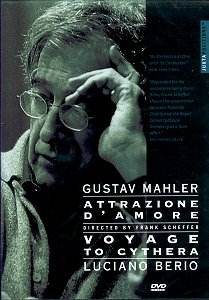What a pleasure it is to follow this
new series by Allegri Films, "Juxtapositions"
which puts together different musicians
and music. In much the same way that
a chemical reaction creates something
new, these films bring together opinions
that continue to spark off new ways
of thinking about music, even after
the films have ended. Apart from anything
else they show the creative processes
by which musicians create their responses
to music.
This particular DVD
brings together Mahler and Berio, both
placed in the context of their place
in music history. Both studied the past,
though what they created presaged the
future. Thus the first film starts with
Riccardo Chailly paying homage to Willem
Mengelberg, his predecessor in Amsterdam.
Seeing Mengelberg’s handwritten notes
on his scores intimately captures the
Concertgebouw’s great Mahler tradition.
Chailly then notes that for Mengelberg,
Mahler was "new" music. He
praises Mengelberg’s "open mindedness".
The film follows the orchestra in rehearsal,
playing Mahler’s Fifth Symphony, interspersed
with comments from the musicians themselves,
on how they adapted their traditions
to the new conductor. "We had to
play with more energy, because he radiated
it", said one. An orchestra as
superb as the Concertgebouw, said Chailly,
was so good and full of potential that
conducting it was like "driving
a powerful car". Thus the orchestra
had much to give even in repertoire
new to them, like Varèse’s Amériques.
Chailly calls it "genius music".
For Chailly, there are conductors who
can’t help but do their own thing. He
says his approach is to study the past
before even starting to interpret. "You
can renew only if you know; you must
understand and study to be able to makes
changes".
The second film, A
Voyage to Cythera, however, is much
more unusual, and should be the real
selling point of this set. It is much
more tightly focused, breaking new ground
in the idea of filmed music. Cythera
in mythology was the home of the goddess
of love and renewal, or creative regeneration.
Thus the film starts with shots of a
strange primordial looking landscape
out of which strains of Mahler’s Sankt.
Antonius Fischpredigt seem to arise.
But it’s Berio’s own transcription of
the song, from his Sinfonia.
Berio describes his work as an "internal
monologue" which makes a "harmonic
journey" through the music of the
past, to find a new means of expression
for the future. To develop his vision
Mahler was unusually erudite musically.
The film follows Berio around his study,
and gradually the camera starts to lurch
up and down, like a ship on the waves,
while music expands beyond. Nothing
needs to be said. Berio is on his journey
to Cythera. It also reinforces wordlessly
Berio’s comment that all things have
their opposites, and modern music navigates
between different poles of tonality.
Chailly returns, talking about Schoenberg
and Stravinsky. Transcription has always
been a part of music, refreshing itself
with each new approach. Stravinsky’s
Noces, for example went through
many stages of development. There is
some lovely footage of Stravinsky conducting,
singing along, immersed in his music.
Berio then describes
his aims in Sinfonia. Mahler
may be the central figure, but equally
integral are the references to Ravel,
Strauss, Hindemith, even Stockhausen
and Boulez. Berio was looking for a
different way of setting text and music,
one which expressed duality and fluidity.
Just as the music generates constant
external references, so does Beckett’s
text, turning the very idea of firm
reality upside down. In floats a comment
from Louis Andriessen: what Berio is
doing is like what Ravel did with the
waltz, deconstructing and rebuilding,
creating an "apotheosis".
An artist, he says, is a mirror on his
times but disappears in his art. Thus
the film technique itself seems to dissolve
into constant flux: images of the past
appear, and there are short unexplained
shots of Haitink, Muti and Boulez. The
film seems to be expressing the inner
spirit of Sinfonia, following
its changing flurries and eddies. As
the text says, "For the unexpected
is always upon us". The visual
technique is somewhat unsettling, yet
is in complete harmony with the music
and with the ideas it presents. As one
of the conductors says, "I don’t
like music that confirms what we already
know".
As the film ends, you
realise that you’ve been on a journey
too, travelling along with an excellent
performance of Sinfonia, experiencing
it on many different levels, just as
Berio intended.
Anne Ozorio


